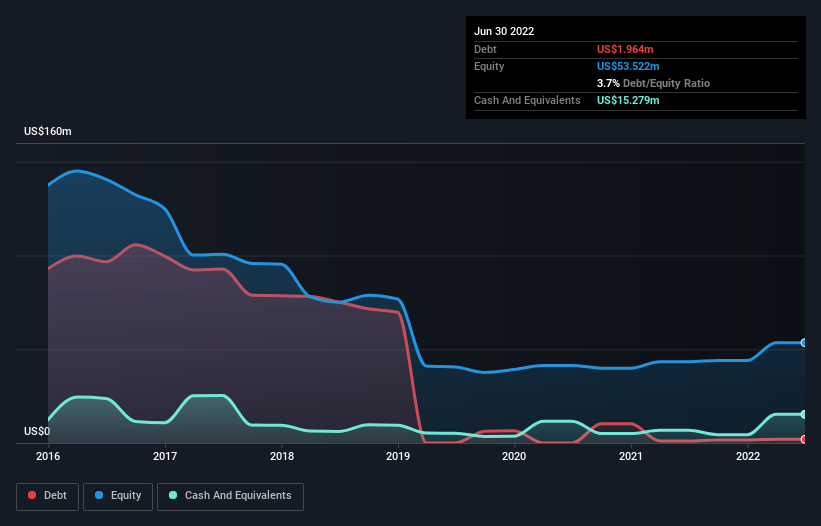Howard Marks put it nicely when he said that, rather than worrying about share price volatility, 'The possibility of permanent loss is the risk I worry about... and every practical investor I know worries about.' When we think about how risky a company is, we always like to look at its use of debt, since debt overload can lead to ruin. We note that Wellard Limited (ASX:WLD) does have debt on its balance sheet. But should shareholders be worried about its use of debt?
What Risk Does Debt Bring?
Debt is a tool to help businesses grow, but if a business is incapable of paying off its lenders, then it exists at their mercy. If things get really bad, the lenders can take control of the business. However, a more frequent (but still costly) occurrence is where a company must issue shares at bargain-basement prices, permanently diluting shareholders, just to shore up its balance sheet. By replacing dilution, though, debt can be an extremely good tool for businesses that need capital to invest in growth at high rates of return. When we think about a company's use of debt, we first look at cash and debt together.
Our analysis indicates that WLD is potentially undervalued!
What Is Wellard's Debt?
The image below, which you can click on for greater detail, shows that at June 2022 Wellard had debt of US$1.96m, up from US$1.12m in one year. However, its balance sheet shows it holds US$15.3m in cash, so it actually has US$13.3m net cash.

A Look At Wellard's Liabilities
We can see from the most recent balance sheet that Wellard had liabilities of US$9.91m falling due within a year, and liabilities of US$106.0k due beyond that. On the other hand, it had cash of US$15.3m and US$1.68m worth of receivables due within a year. So it actually has US$6.94m more liquid assets than total liabilities.
It's good to see that Wellard has plenty of liquidity on its balance sheet, suggesting conservative management of liabilities. Given it has easily adequate short term liquidity, we don't think it will have any issues with its lenders. Succinctly put, Wellard boasts net cash, so it's fair to say it does not have a heavy debt load! When analysing debt levels, the balance sheet is the obvious place to start. But it is Wellard's earnings that will influence how the balance sheet holds up in the future. So when considering debt, it's definitely worth looking at the earnings trend. Click here for an interactive snapshot.
In the last year Wellard wasn't profitable at an EBIT level, but managed to grow its revenue by 3.7%, to US$45m. We usually like to see faster growth from unprofitable companies, but each to their own.
So How Risky Is Wellard?
Although Wellard had an earnings before interest and tax (EBIT) loss over the last twelve months, it made a statutory profit of US$9.9m. So taking that on face value, and considering the cash, we don't think its very risky in the near term. With mediocre revenue growth in the last year, we're don't find the investment opportunity particularly compelling. The balance sheet is clearly the area to focus on when you are analysing debt. However, not all investment risk resides within the balance sheet - far from it. These risks can be hard to spot. Every company has them, and we've spotted 2 warning signs for Wellard you should know about.
If you're interested in investing in businesses that can grow profits without the burden of debt, then check out this free list of growing businesses that have net cash on the balance sheet.
Valuation is complex, but we're here to simplify it.
Discover if Wellard might be undervalued or overvalued with our detailed analysis, featuring fair value estimates, potential risks, dividends, insider trades, and its financial condition.
Access Free AnalysisHave feedback on this article? Concerned about the content? Get in touch with us directly. Alternatively, email editorial-team (at) simplywallst.com.
This article by Simply Wall St is general in nature. We provide commentary based on historical data and analyst forecasts only using an unbiased methodology and our articles are not intended to be financial advice. It does not constitute a recommendation to buy or sell any stock, and does not take account of your objectives, or your financial situation. We aim to bring you long-term focused analysis driven by fundamental data. Note that our analysis may not factor in the latest price-sensitive company announcements or qualitative material. Simply Wall St has no position in any stocks mentioned.
About ASX:WLD
Wellard
Engages in the supply of livestock and livestock vessels in Australia, Singapore, and internationally.
Flawless balance sheet with slight risk.
Market Insights
Community Narratives



